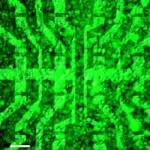 The graphene based transistor array and its layer of biological cells that it covers it is now showed due to a combination of optical microscopy and fluorescence imaging.
The graphene based transistor array and its layer of biological cells that it covers it is now showed due to a combination of optical microscopy and fluorescence imaging.
This is possible through an experimental device created by scientists from the Technische Universitaet Munchen and the Juelich Research Center in this nanotechnology science.
This kind of device proved capable of recording signals generated by living cells, with good spatial a temporal resolution. This demonstration opened the way to further investigation of the feasibility to use grapheme based bioelectronics for future bioelectronic applications such as neuroprosthetic implants into the brain, the eye or the ear.
Future bioelectronic applications have been proposed to place sensors and in some cases actuators inside the brain, ear or eye to help compensate for neural damage. The research in this direction was done using the mature technology of silicon microelectronics.
Now this approach is too noisy for reliable communications with individual cells. Graphene as two dimensional sheets of carbon atoms is very well suited to bioelectronic applications. Its advantages are electronic performance, chemically stability, biological inertia, the possibility to be processed on flexible substrates and the low cost fabrication.
“The sensing mechanism of these devices is rather simple,” says Dr. Jose Antonio Garrido, a member of the Walter Schottky Institute at TUM. “Variations of the electrical and chemical environment in the vicinity of the FET gate region will be converted into a variation of the transistor current.”
For example, a series of spikes separated by tens of milliseconds moved across the transistor array in just the way action potentials could be expected to propagate across the cell layer. Also, when the cell layer was exposed to a higher concentration of the stress hormone norepinephrine, a corresponding increase in the frequency of spikes was recorded.
“Much of our ongoing research is focused on further improving the noise performance of graphene devices,” Garrido says, “and on optimizing the transfer of this technology to flexible substrates such as parylene and kapton, both of which are currently used for in vivo implants.



